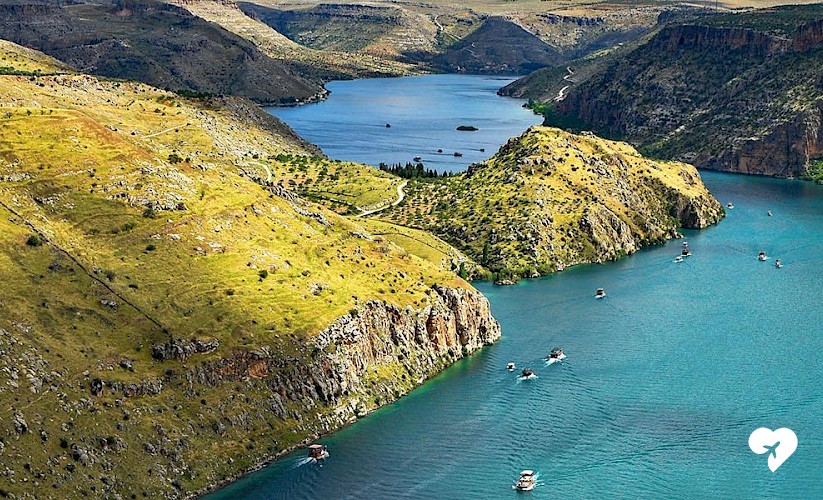In part 1 we took you through a couple of the sights of Mesopotamia, but unsurprisingly this is a region where the sights to see simply don’t end. It’s a fantastic place to discover the roots of civilization itself over the course of a long weekend, so buckle up and see where else you need to explore in this ancient, magical land!
Şanlıurfa: Halfeti

Halfeti is one of the oldest surviving settlements in all of Mesopotamia, and certainly one of the most impressive. Much of the city is under water, part of the effects of climate change and modernization, but much of the history can still be seen under water and 20% of the ancient city still remains above water.
The Euphrates River is at its most beautiful in this spot, with stone architecture beneath the surface revealing a hidden paradise. It’s also known as one of the world’s great “Lost Cities” to visit, where you can literally see remains as the waves ripple over them. It’s only of 208 cities in the world, and 11 in Turkey, to have been awarded a “Cittaslow” award for its peace, calm and beauty.
Gaziantep: Yesemek Open Air Museum

Yesemek was the largest stone quarry and a sculpture workshop in the Near East between the 14th and 7th centuries B.C. Naturally, this made it a source of major production and was one of the most important sights during the heyday of Mesopotamia.
The modern open-air museum features over 300 sculptures of all varieties that have been dug up from the ground and are exhibited all around the area. The lion sculptures in particular are quite striking. But there are monumental sphinxes, bears, men as bears, chariots, mountain men who represent the mountains of Amanos, relief scenes, and architectural works that are incredible in their detail, and simply unbelievable when you realize that many of these works are up to 3,000 years old. Excavation and archaeological work is ongoing at Yesemek, and every day new wonders are unearthed shedding light on the artistry and magnificence of these ancient civilizations.
Adiyaman: Mount Nemrut
.jpg)
The sculptures at Mount Nemrut were built by King Antiochus I Theos of Commmagene as a tomb-sanctuary for himself. The sculptures are of himself, of himself, two lions, two eagles and various Greek, Armenian, and Medes gods, such as Zeus-Aramazd or Oromasdes (associated with Zoroastrian god Ahura Mazda), Hercules-Vahagn, Tyche-Bakht, and Apollo-Mihr-Mithras.
The sculptures themselves show the “East meets West” nature of the kingdom, as the facial features are Greek but the clothing they’re wearing is decidedly more Eastern. They are no longer standing in their original positions, but the scattered effect of the sculpture’s current positions is almost more jarring than if they were neatly in a row as they almost certainly were originally intended.
The site as a whole is massive, with a 49-meter-tall tumulus on site (mound of earth and stones raised over tombs).
Adıyaman: Ancient City of Perre

The ancient city of Perre was one of the five largest cities of the Commagene Kingdom. The city’s importance lasted through the Roman period as a critical trading post between the Commagene capital of Samosata and Melitene. It also was a critical religious site and was mentioned during the council of Nicaea in the early period of Christianity. The most remarkable ruins in the ancient city are the rock tombs located at the entrance of the Örenli district. The chamber tombs carved into the rocks are marvelous.
